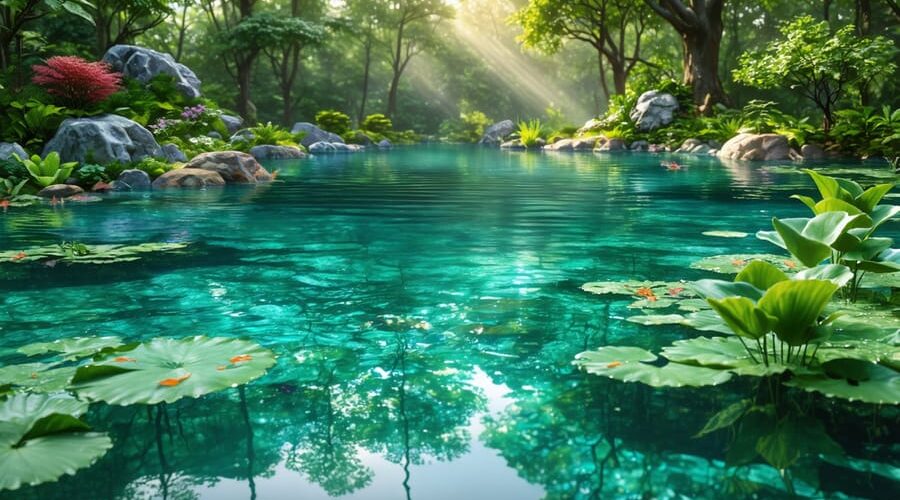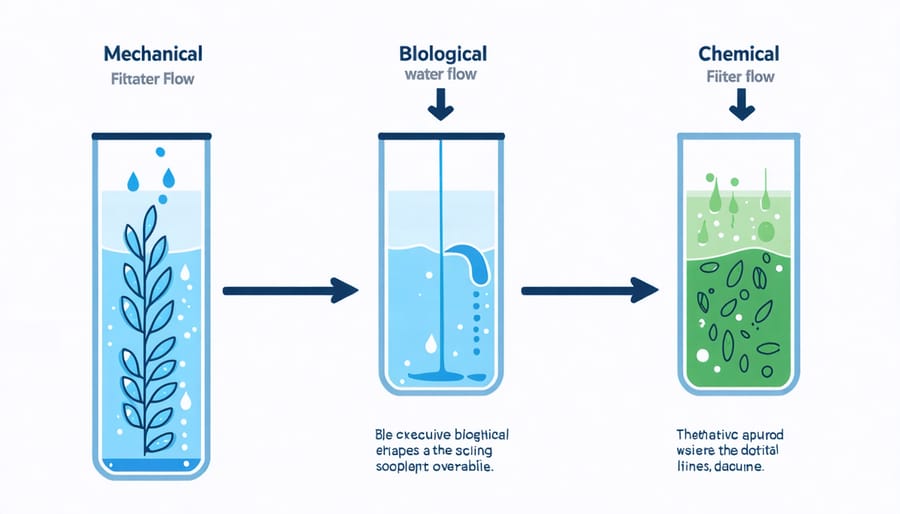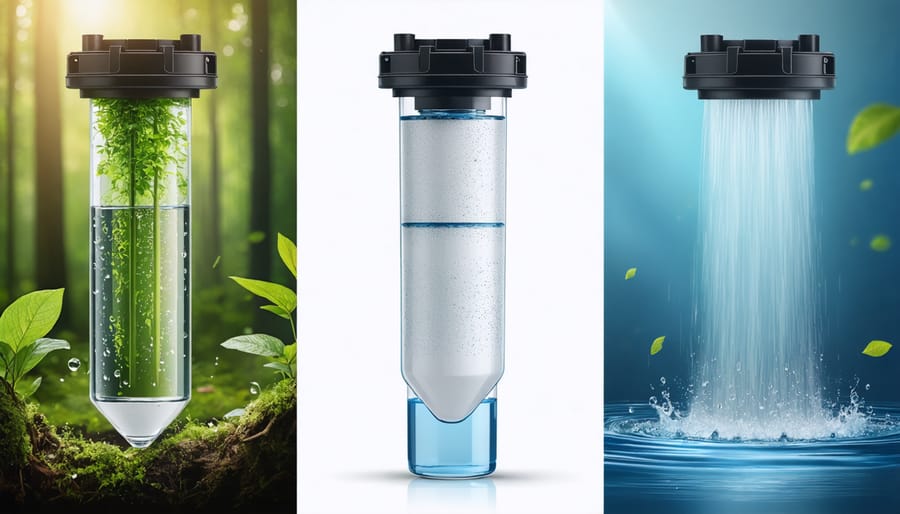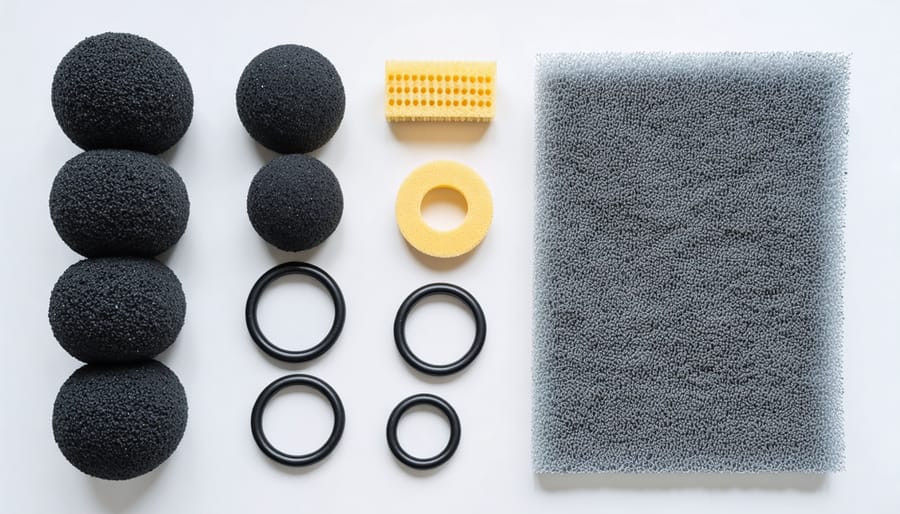
Transform Your Murky Pond into Crystal Clear Paradise with Biological Filtration
Transform your pond into a self-sustaining ecosystem with a biological filter – nature’s most efficient water purification system. By harnessing the natural filtration process, these remarkable systems cultivate beneficial bacteria that break down harmful waste, converting toxic ammonia into harmless compounds. Unlike mechanical filters that simply trap debris, biological filters create a living ecosystem that continuously cleans your pond water, supports healthy fish populations, and reduces maintenance requirements.
Whether you’re a novice pond keeper or seasoned enthusiast, understanding biological filtration is crucial for maintaining crystal-clear water and thriving aquatic life. These systems work tirelessly behind the scenes, mimicking the pristine conditions found in natural lakes and streams. By providing the perfect environment for beneficial microorganisms, biological filters offer a sustainable, eco-friendly solution that transforms murky, problematic ponds into clear, balanced water features that bring joy year after year.
How Biological Pond Filters Work Their Magic
The Science of Beneficial Bacteria
The real magic of biological pond filters happens thanks to tiny heroes called beneficial bacteria. These microscopic workers tirelessly break down harmful waste products in your pond, creating a healthy environment for your fish and plants.
Two main types of bacteria work together in this process. First, Nitrosomonas bacteria convert toxic ammonia (from fish waste and decaying matter) into nitrites. Then, Nitrobacter bacteria take over, transforming these nitrites into much safer nitrates that plants can use as fertilizer. This process, known as the nitrogen cycle, is nature’s way of keeping water clean.
Think of these bacteria as your pond’s cleaning crew, working 24/7 to maintain water quality. They naturally colonize filter media like bio-balls, sponges, and ceramic rings, forming a sticky biofilm that traps and processes waste. The more surface area your filter media provides, the more bacteria can grow and the more efficient your filtration becomes.
These helpful bacteria need time to establish themselves, usually taking 4-6 weeks in new ponds. They also prefer stable conditions with good oxygen levels and temperatures between 45-85°F.
The Three Stages of Biological Filtration
Biological pond filtration works through three distinct but interconnected stages, each playing a vital role in keeping your pond water crystal clear and healthy. The first stage, mechanical filtration, acts like a bouncer at a club, catching larger debris like leaves, twigs, and fish waste before they can break down in your pond. Think of it as a series of increasingly fine nets catching particles of different sizes.
The second stage, biological filtration, is where the real magic happens. Beneficial bacteria colonies make their home in your filter media, breaking down harmful ammonia from fish waste into less harmful nitrites, and finally into relatively harmless nitrates. This process, known as the nitrogen cycle, is essential for a healthy pond ecosystem.
Finally, chemical filtration helps remove dissolved pollutants and fine particles that slip through the first two stages. Special filter media like activated carbon or zeolite work like tiny magnets, attracting and holding onto these unwanted substances. Together, these three stages create a powerful cleaning system that keeps your pond water safe and clear.

Choosing the Right Biological Filter for Your Pond
Popular Filter Types Compared
When it comes to biological pond filters, you’ve got three popular options to choose from, each with its own set of advantages. Box filters are the workhorses of pond filtration, sitting beside your pond and offering excellent biological filtration through multiple chambers. They’re easy to maintain and perfect for medium to large ponds, though they do take up some space in your garden.
Pressure filters are the compact champions, working well for smaller ponds and tucked-away installations. These sealed units can be buried underground, making them practically invisible in your landscape. They work under pressure, which means you can position them below or above water level, offering great flexibility in your pond design.
Waterfall filters combine functionality with beauty, creating a stunning water feature while cleaning your pond. They sit at the top of your waterfall, disguised as a natural rock formation, and use gravity to filter water as it cascades down. While they might not handle the heaviest bioloads, they’re perfect for adding both filtration and that soothing sound of falling water to your pond.
For smaller ponds under 1,000 gallons, a pressure filter might be your best bet. Medium-sized ponds often do well with box filters, while larger installations might benefit from combining different types. Remember, the best filter for your pond depends on its size, fish stock, and your landscape design preferences.

Sizing Your Filter Correctly
Properly sizing your biological pond filter is crucial for maintaining a healthy aquatic environment. Choosing the right filter size depends on several key factors that work together to keep your pond crystal clear.
As a general rule, your filter should be able to process your pond’s entire water volume at least once every two hours. For example, a 1,000-gallon pond needs a filter rated for at least 500 gallons per hour. However, this is just the starting point!
Consider your fish population carefully. For each inch of fish, add an extra 10% to your filter capacity. If you’re keeping koi, which produce more waste than goldfish, increase this to 20%. A heavily stocked pond might need double the basic filtration requirement.
Other factors that influence filter sizing include:
– Amount of direct sunlight your pond receives
– Number of plants in your system
– Local climate and temperature variations
– Feeding habits and frequency
Don’t fall into the trap of underestimating your needs – it’s always better to go slightly larger than necessary. A filter that’s too small will struggle to keep up with waste production, leading to cloudy water and unhappy fish. On the flip side, an oversized filter provides extra buffering capacity during high-load periods, like summer months or when hosting more fish.
For best results, consider your future plans too. If you’re thinking about adding more fish or expanding your pond later, factor this into your initial filter selection.
Setting Up Your Biological Filter System
Installation Best Practices
For successful biological filter installation, location is key. Place your filter where it’s easily accessible for maintenance while ensuring proper water flow. Most pond owners position the filter slightly above water level on the opposite side of the waterfall or fountain for optimal circulation. Check out our comprehensive DIY filter installation guide for detailed setup instructions.
When installing, create a stable, level base using concrete blocks or a sturdy platform. This prevents shifting and maintains proper water flow. Connect your pump to the filter using appropriately sized tubing, ensuring all connections are secure and leak-free. Consider installing unions or quick-disconnect fittings to make future maintenance easier.
Layer your filter media properly, starting with coarse material at the bottom and progressively finer media toward the top. This creates an effective gradient for mechanical and biological filtration. Leave enough space between media layers for beneficial bacteria to colonize and water to flow freely.
Remember to position the outlet pipe slightly higher than the inlet to prevent backflow. If you’re incorporating a UV clarifier, install it before the biological filter to prevent harmful UV rays from affecting your beneficial bacteria colony. Finally, run your system for 24-48 hours to check for leaks and ensure proper flow rates before adding fish to your pond.
Filter Media Selection
Choosing the right filter media is crucial for your pond’s biological filtration success. Start with mechanical media like foam or filter mats at the first stage to catch larger debris. These should be coarse at the inlet, becoming progressively finer to trap smaller particles.
For biological filtration, combine different media types in layers. Bio-balls and plastic pot scrubbers work well in the upper layers, providing excellent surface area for beneficial bacteria while maintaining good water flow. Below these, add ceramic rings or lava rock, which offer dense colonization spaces for bacteria. K1 media is fantastic for moving bed sections of your filter, as it keeps water circulating while hosting beneficial bacteria.
For the bottom layer, consider using zeolite or activated carbon, which help remove dissolved waste and improve water clarity. When arranging media, ensure there’s enough space between pieces to prevent clogging and maintain proper water flow. Remember, it’s better to have too much filtration media than too little – aim for about 10-15% of your pond’s volume in filter media space.

Maintaining Your Biological Filter
Regular Maintenance Schedule
To keep your biological pond filter working efficiently, follow this simple maintenance schedule. Weekly tasks include checking the pump flow and removing any visible debris from the filter media. This quick inspection helps prevent major issues and ensures smooth operation.
Monthly maintenance involves a more thorough check of your filter media. Gently rinse mechanical filtration components in pond water, never tap water, to preserve beneficial bacteria. Also, inspect UV bulbs if your system includes them, and clean any pre-filter sponges.
Every three to four months, perform a deeper cleaning of your biological media. However, only clean about one-third of the media at a time to maintain your bacterial colony. This is also a good time for maintaining proper water chemistry by testing water parameters.
Annually, typically in early spring, conduct a comprehensive system check. Replace UV bulbs if needed, thoroughly clean all components, and inspect for any wear and tear. Check seals and connections, and replace any damaged parts before the busy season begins.
During winter, if your pond remains active, reduce feeding and maintain minimal filtration to prevent freezing. For shutdown periods, clean and store filter media properly to ensure a smooth startup in spring.
Remember, these are general guidelines – adjust the schedule based on your specific pond conditions and seasonal changes.
Common Problems and Solutions
Even the best-maintained biological filters can encounter issues, but most problems have straightforward solutions. If you notice cloudy water, this often indicates an immature filter system or recent cleaning that disrupted beneficial bacteria. Simply give your filter time to rebuild its bacterial colony, usually about 2-3 weeks.
When you detect unpleasant odors, it typically means there’s insufficient oxygen flow. Check your air pump and clean any clogged air stones. Also, ensure your filter media isn’t too tightly packed, as this can restrict water flow and create anaerobic zones.
Poor water quality despite a running filter might mean your system is undersized for your pond. Calculate your pond’s volume and ensure your filter can handle the load. Remember that overstocking fish or overfeeding can overwhelm even a properly sized filter.
If water flow seems reduced, inspect for blockages in pipes or filter media. Regular maintenance prevents most flow issues, but be careful not to clean all media simultaneously, as this removes too many beneficial bacteria at once.
Green water usually indicates excess nutrients. Add more plants to compete with algae for nutrients, and consider using UV clarification as a supplement to your biological filtration. If problems persist, test your water parameters to identify specific imbalances needing attention.
Implementing a biological pond filter is one of the best investments you can make for your water garden. These natural filtration systems not only keep your pond water crystal clear but also create a healthier environment for your fish and plants. By harnessing the power of beneficial bacteria, biological filters work tirelessly to break down harmful waste products, maintaining the delicate balance of your pond’s ecosystem.
The benefits of biological filtration extend far beyond just clean water. You’ll spend less time on maintenance, reduce the need for chemical treatments, and create a more sustainable environment that works in harmony with nature. Your fish will thrive in the improved water conditions, and you’ll notice enhanced plant growth thanks to the balanced nutrient levels.
If you’re still considering whether to add a biological filter to your pond, remember that it’s an investment that pays off in multiple ways. You’ll save money on chemicals and maintenance products in the long run, and more importantly, you’ll have peace of mind knowing your pond is being cleaned naturally and effectively.
Getting started with biological filtration doesn’t have to be complicated. With the right setup and regular maintenance, you can enjoy a clearer, healthier pond that practically takes care of itself. Take that first step toward a more balanced pond ecosystem – your fish, plants, and future self will thank you for it.
